9 signs that your intranet is failing
You can’t just flick the ‘on’ switch for an intranet and leave it: without even light-touch care, it can quickly spiral into disaster. But what are the warning signs that your intranet is headed for failure?
The success of our customers as international award winners is often celebrated. However, it’s easy to forget that each of those winners originally classified their old intranet as ‘failing’ before making changes to resolve it and winning that recognition.
Failure, then, may actually be the starting point for success.
Although failure can be occasionally postponed or slowed down with minor amendments, small changes, or without the need for costly third-party consultancy, it’s not a cure. Ultimately, if you’re reading these indicators and nodding your head, your intranet is failing. It’s time for action.
The cost of intranet failure
While some organizations shy away from change, fearing the investment cost or resource requirements, the long-term cost of failure may be far greater.
At the most fundamental and basic level, an intranet exists to provide staff with communication, content, and a place to go to to support their day-to-day roles. Failing to deliver on any of these basic principles can have a ripple effect: impacting on staff productivity, engagement, morale, through to business outcomes including customer service. brand reputation, and turnover.
A failing intranet, then, is not simply a problem because it isn’t delivering a return on your investment. It could potentially expose your entire organization to significant risk.
What’s more, fears about intense resource requirements and large-scale intranet projects in order to see success are often unfounded. Less than 3% of Interact customers need a full time Intranet Manager to achieve their success, and in some cases – as with our customer Make-A-Wish Foundation – making the decision to move to Interact actually reduces the workload of those people previously charged with maintaining the intranet to such an extent, they are able to pick up additional roles. Addressing a failing intranet may actually deliver a significant overall return for your business.
Here, we share the frustrations of several award winners that prompted them to make a change to Interact.
- Analytics show your intranet is failing, or worse, you have no analytics at all
You can use a range of methods to judge success; whether it be the percent of users over a certain period, activities completed, pulse surveys on your site that allow you to spot changes in user perception, or even more in-depth surveys.
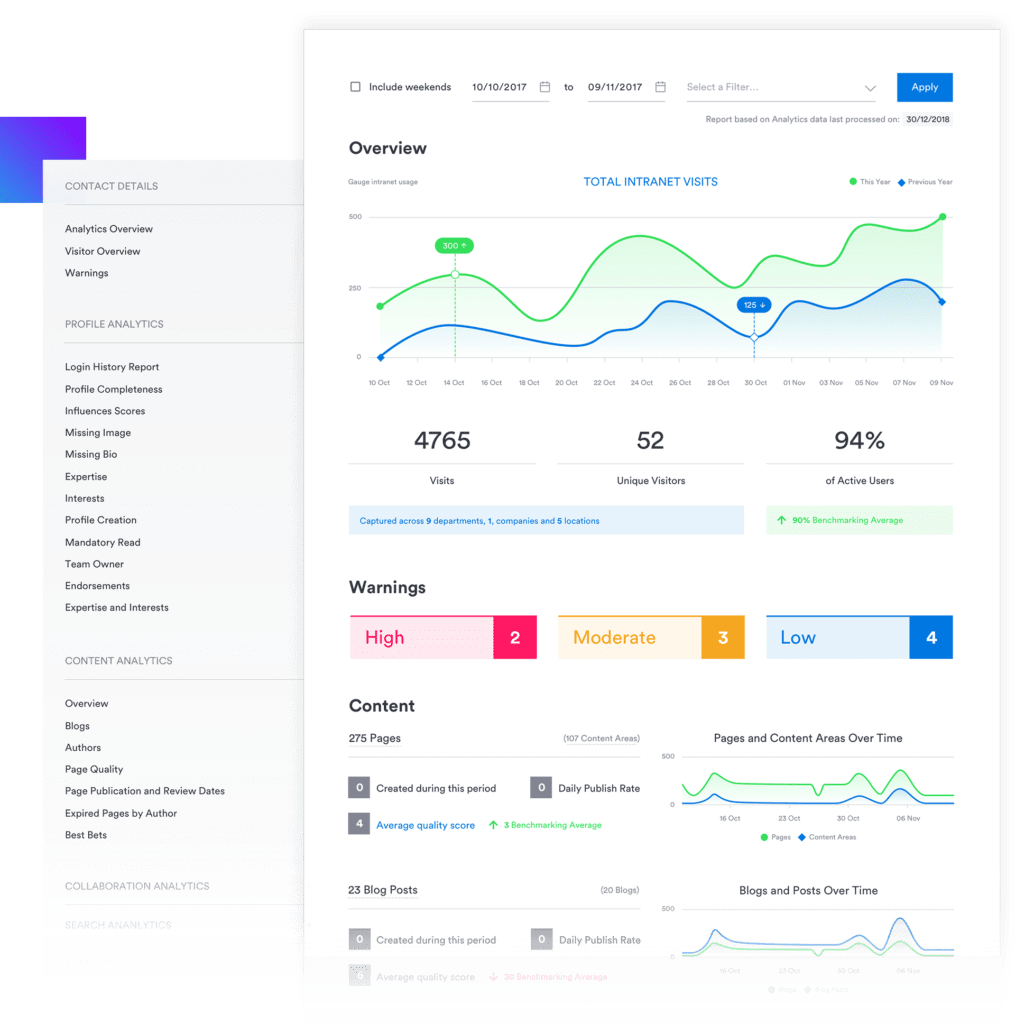 (Intranet analytics provide valuable insights that can help you identify engagement levels, failing areas of your platform, inactive/disengaged users, and more.)
(Intranet analytics provide valuable insights that can help you identify engagement levels, failing areas of your platform, inactive/disengaged users, and more.)
All of these approaches should be available on your site to inform you of the effectiveness of your work. However, some companies approach us with no analytics at all. With absolutely no quantitative data, it proves impossible for them to know what ‘good’ looked like on their site – or to get those all-important red flags when things weren’t performing as they should.
Once you start to understand what is effective (and what isn’t!) on your site, you can taper and modify your approach to maximize success.

This was the case for double Ragan Award winners, Travelex. Through evaluating and building on the insights gained from their intranet analytics, Travelex was able to pinpoint their most successful features and focus their efforts on developing them further.
One of the primary objectives set for The Lounge was to connect employees: not just on a professional level, but as individuals within a wider community. For employees on the frontline in bureaus, a new intranet would provide a sense of unity and inclusion, building on Travelex’s virtual global culture.
Observing the success and engagement levels on the blogs featuring on The Lounge through their analytics, Travelex set out to drive more user-generated content and to position blogs prominently on the homepage of their intranet, in line with its intranet objectives. With regular fresh content and contributions from across its global workforce, Travelex was able to drive engagement and interaction for a truly successful intranet.
Travelex Intranet Manager, Tricia Scott, explains:
“The biggest hit on The Lounge are our blogs. Our analytics show we average 11 blogs a day!
“Everyone, from senior executives through to bureau workers, has a chance to get support and share their stories with a wider audience. Even our CEO contributes regular vlogs and comments on staff posts, engaging with all our users.”
“We have staff writing about things that go way beyond their day jobs. People are supporting each other through illnesses, divorces, and other challenges – and these are people from all over the world who may never have met each other face to face.
“They’re also sharing positive stories and experiences, which is helping us to embed a common culture.
“We recently celebrated our 1-year anniversary, and part of the campaign was to allow colleagues to vote for their Blog of the Year. The winner by a mile was by a sales consultant who achieved over 400 likes for a personal blog, which shared how the business had helped her put her life back together again.”
Tricia Scott, Intranet Manager
Travelex, Ragan Award Winners for Best Social Intranet and Best Blog Series
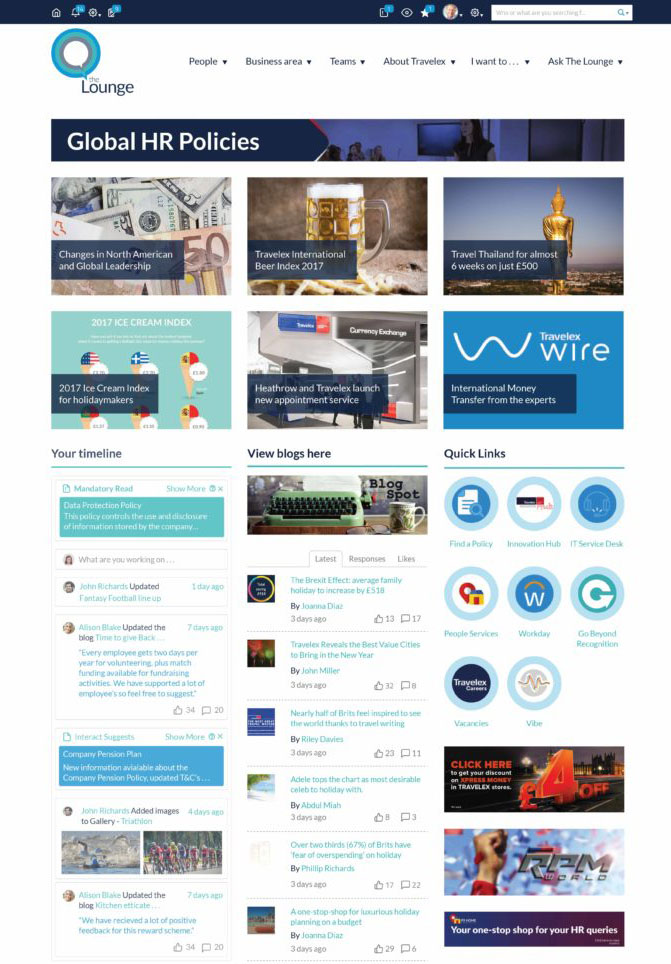
- You’re communicating major news by email or company magazine, rather than your intranet
This can happen for various reasons, ranging from the mantra of, “but we’ve always done it that way”, to a dependency on IT to create the necessary pages as your intranet platform is difficult to use, or perhaps your intranet page composer has limitations, resulting in ugly pages. If your intranet has become a document dumping ground or the content is stagnant, rarely changing, it won’t draw users to seek out company news or information. In these cases, its no wonder we revert to the fail-safe email or print methods.
These methods have significant challenges, however; ultimately, they are not designed for effective one-to-many internal communication.
Email can be unwieldy and drive you towards oceans of text, losing your readers and failing to get the message across. The sheer volume of emails sent daily can mean it’s easily missed; this is made even worse when somebody hits the dreaded Reply All button. The overload makes it easy for employees to miss important messaging.
Furthermore, you may have employees who can only access your communications via a personal device; for example, frontline staff or those operating on the production line. They may not even have a company email account. If these members of staff are forced to wait for a periodic company magazine or, worse still, don’t receive any communication at all, they can quickly become the ‘forgotten’ workforce: resulting in disengagement.
Company magazines, whilst critical, are also rarely timely. If you find yourself publishing Christmas Party photos in mid-February, it may be time to provide more immediate information for the masses.
An accessible intranet designed for mobile with a native app will allow your users to see what’s happening, participate in company-wide discussions, and access information quickly and easily on-the-go. With an easy-to-use and intuitive CMS, it should also be easy to update on a regular basis: keeping content fresh, relevant, and giving users a reason to keep coming back.
Take a page from our customer NSPCC’s book.

The NSPCC have been able to drastically reduce email reliance since launching their new intranet:
“When you have a message to communicate, it’s easy to send an email. That means everyone’s read it and actioned it right?! Unfortunately, staff receive too many emails – they don’t know what to prioritize and often don’t read them – and some get more time and opportunities to read their emails than others.
“And not to mention those big attachments that strain the sides of your mailbox so you’re regularly receiving that dreaded message – ‘You’ve reached your mailbox limit’ – ironically sent in an email!
“This meant it was important for our new intranet to help reduce the number of emails and attachments being sent, facilitate better two-way communication and host content that has a wide audience.”
Katie Hawkins, Internal Communications Manager
NSPCC – Best Intranet Launch Winners 2016
- Doing what should be a simple task on your intranet takes all day
If creating a single page on your intranet requires you to know how to code or demands input from multiple individuals to complete, updating your intranet is never going to be effortless. That doesn’t even touch upon, heaven forbid, if you take a holiday and somebody has to cover.
Similarly, waiting for IT to develop an intranet feature which everybody else seems to have had for years can drive you to the point of distraction. Technology development is fast-paced and failing to keep up with trends and demands from your users can quickly lead to your intranet becoming obsolete.
It’s not just about those tasks required to build and maintain your intranet, either. Ultimately, an intranet is there to serve your users. If it isn’t familiar, easy to use, intuitive, or it lacks adequate attention to user experience (UX), frustration will build and usage will fall away. Your users need to be able to find the information they need, complete tasks in a self-serving manner, and engage with your intranet – by themselves.
Just 3% of Interact customers have a full time Intranet Manager; it’s often a role that emerges as the intranet evolves to pick up a host of new requirements, and generally seen in much larger enterprises where the sheer volume of content on the intranet makes for a full-time role.
For the vast majority of customers, though, intranet management can be assigned to one or a group of existing individuals in the business. User-generated content and engagement fills the demand for fresh content, rather than relying on a single or small group of individuals. This can be attributed to Interact’s out-the-box and easy to use functionality, designed for communicators, alongside the regular and seamless product updates conducted by our own in-house team. The result is significant time and resource savings for our customers.
Make-A-Wish Foundation saved 20 hours per week by changing their intranet:

“Shortly after the site went live, we quickly saw the benefits to the organization.
“Support for the prior intranet required a full-time staff person. The renovated site, although much more feature-rich, is simpler to govern. It cut the needs from a human capital standpoint by 50% and allowed us to allocate 20 hours per week of the intranet manager’s time to other duties.
“In addition, the site saves staff an immense amount of time that was previously dedicated to trying to find the proper resources on the old intranet.”
Jamie Sandys
Make-A-Wish Foundation – Ragan Awards Best Value to Employees Winner, Essential Intranet Winner
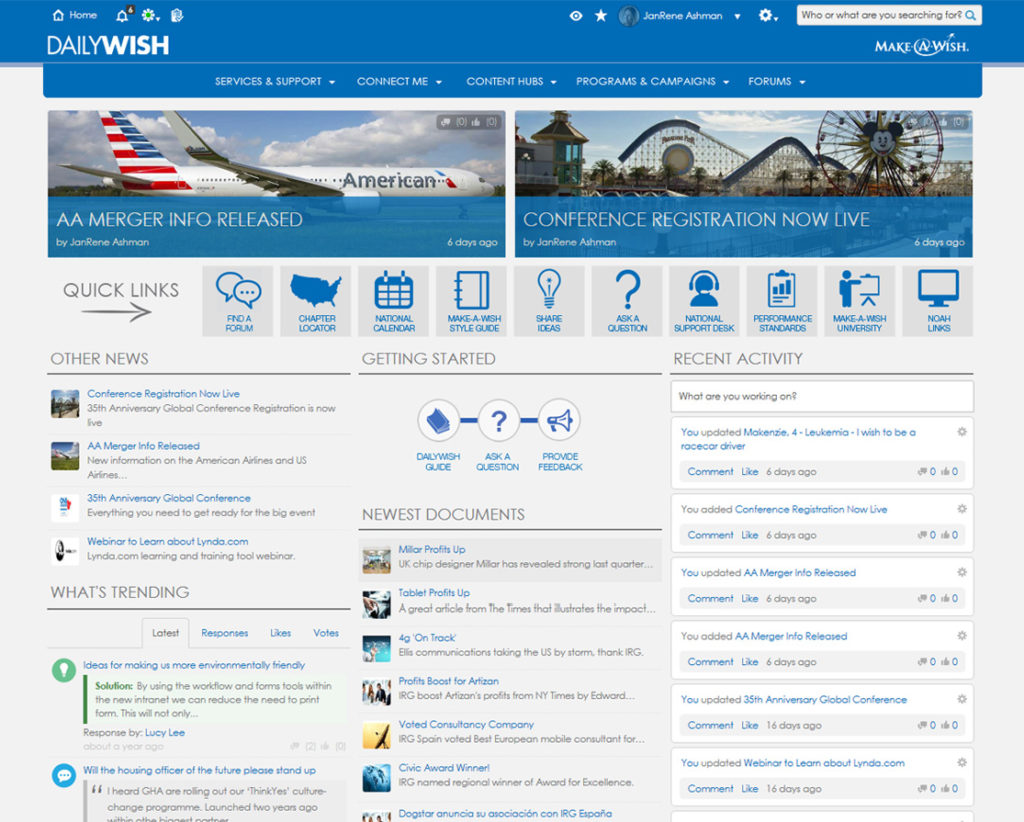
- You hate your intranet and it looks dreadful
If your intranet is bad, it’s fine to hate it. In fact, recognizing the poor quality of your intranet is the first step toward getting it upgraded. There’s nothing worse than your users seeing your intranet as a reflection of your work and every complaint striking you to the core; particularly when you’re trying every method possible to get something to work.
If you’re finding that no matter how hard you work, your site still looks dated and uncared for, (despite your best efforts) than it’s a sure sign your intranet is failing and in need of a makeover.

Sheetz suffered exactly this:
“Unsearchable. Outdated. Frustrating. These terms accurately describe Portal 8, a nine-year-old-platform, that had never had a true ‘refresh’ outside of updating the company logo in 2014. Portal 8 had become an online billboard full of buttons and bulleted lists, because there was no established vision and an absence of an effective business architecture.”
Morgan Williams, Intranet Manager
Sheetz
After gaining insights and feedback from users, Sheetz undertook a complete overhaul. Functionality and accessibility reigned top of the priority list, resulting in a mobile-first design, splash screens as a user-friendly approach to navigation, and a comprehensive content audit to ensure information was easy-to-find. The bright and bold design, along with a user-focused approach, saw Sheetz secure the winning title for Best Intranet Design in 2017.
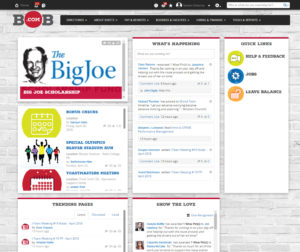
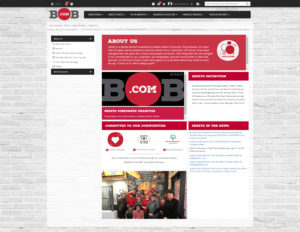
- It’s quicker to call, email, or walk to the person than use your intranet’s search function
Your intranet is supposed to make getting information easier, not more difficult.
Poor search capabilities destroy confidence; whether it’s the inability to find what you need, or finding that the content you need is massively out of date.
Effective search drives productivity and is at the heart of positive user experience. If you can’t make sure relevant content is served immediately, it’s time to look for an alternative.
- Even when you find content, it is often out of date
We’ve already highlighted how few customers need full-time Intranet Managers; however, being a Content Author, even with the best of intentions, would be impossible if that author isn’t being prompted to review content periodically.
Making it effortless to own content is essential. This will then make it easier for users to trust that your content is updated and relevant instead of experiencing the dreaded error page following an out-of-date link.

Before moving to Interact, Sport England faced this very challenge. They found by solving this, they could progress to blogging and 93% of users contributing without any history of it in the organization.
“As well as no search, our old intranet had the familiar problems: much out of date information, no identified information owners, no real governance structure or publishing process and a site structure that replicated our organizational structure and wasn’t very intuitive.
“Plus, the supplier has discontinued support for the platform we were using, and the developer was difficult to get hold of to correct issues and make any changes.
“In short, our intranet was in a pretty bad state. The report card would have read; ‘needs to try harder’.”
Matt Phillipson, Internal Communications Manager
Sport England
After undertaking a dramatic shift in the culture of content ownership for their intranet, Sport England went on to secure recognition as the Ragan Award for Best Value to Employees Winner, alongside winning the Interact Essential Intranet award.
- There are no collaborative features – or you’re not using what you have effectively
Collaboration between employees can help with ideation, faster resolution of problems or challenges, more efficient working, and more. A lack of collaboration features in your intranet creates a ‘read only’ top-down platform, leading to siloes, low engagement, lack of usage, and ultimately, long-term failure.
However, businesses approach collaboration at various paces. It is key to use it where it is applicable and right for your business and its culture, rather than switching on a series of collaborative features and simply saying, “you now have a voice, use it”, to which your audience asks, “use it for what?”
Having collaborative tools you can switch on at your own pace allows you to drip feed new functionality to your employees as the need arises. Your staff will appreciate the efficiency and time saved that collaborating with each other will provide.

Avon and Somerset Constabulary went from a ‘read-only’ intranet to recognition as a Ragan Award winner for Best Value to Employees, after launching their new intranet Pocketbook:
“Before Pocketbook, our previous intranet was distrusted by staff that had to phone other people to get information they could rely on. This was inefficient and wasted multiple people’s time.
“In addition, our old intranet was also “read-only” and we knew we were missing a significant opportunity to benefit from collaborative and “social tools” that modern intranets provide.”
Scott Fulton, Head of Strategic Digital Services
Avon and Somerset Constabulary, Ragan Best Value to Employees Winner, Essential Intranet Winner
Using a variety of techniques ranging from user stories and scenarios to card sorting sessions, Avon and Somerset Constabulary defined a new intranet structure and identified the tools required to support their users. A force-wide training program equipped content publishers and managers with the skills they needed to keep the intranet populated with useful content and information.
“An officer in the field, or a call handler, quickly needs to have access to a large amount of information. For example, a procedure so they can charge a suspect, or the process when finding a victim of crime. Now with Pocketbook, employees are able to perform their duties quicker with a reliable source of information.”
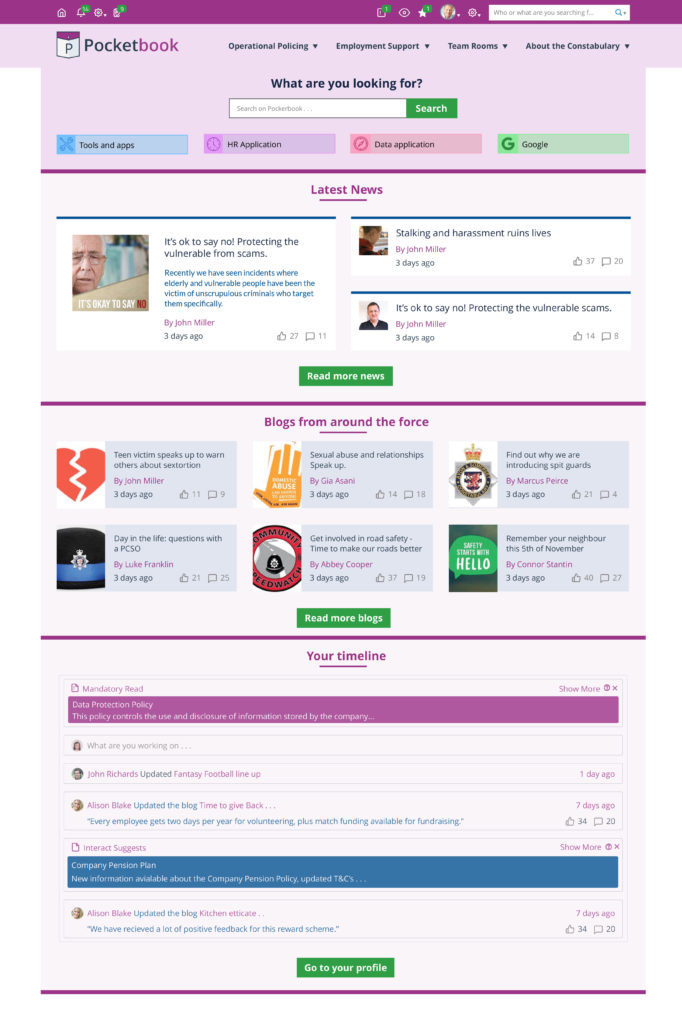
Pocketbook is now an established and critical tool in the organization, connecting staff to collaborate and support one another as well as access the information they need to perform their day-to-day roles.
- You have to remember different passwords for a range of applications
The digital workplace is increasingly diverse, with a vast range of applications available to suit every niche requirement, task, or need. However, that’s a landscape that comes with its own challenges. The technology fatigue of ‘not another application and login to remember!’ can cause low adoption and usage, as well as vulnerability risks if users forget or use weak passwords.
At enterprise level, the average organization has over 500 applications as part of its technology stack. (Source: Forbes)
By enabling users to access applications they need quickly from your intranet without the need to remember a password for each one, you remove the barriers stopping people from being able to complete tasks efficiently. This is achievable through Single Sign-On (SSO) and configuring your intranet as an identity provider.
Interact partners identity management providers such as OKTA, OneLogin and G Suite, as well as native support for ADFS for Office 365 to provide a centralized, one-stop-shop approach to access all your vital business tools and applications.

SkyBet uses their intranet as the launchpad for every application within their business:

“Our people can access all the other business applications they need to manage their daily working life at SBG. SAML single sign on means that users are forced to go through our intranet, SBG & Me, in order to view pay slips, book holidays, manage benefits, raise IT service desk requests – pretty much everything! This is one of our key drivers of engagement and usage.”
Joel Turner, Internal Communications and Engagement Manager
SkyBet, Best Intranet Launch Finalists
- Nobody really knows the purpose of your intranet, what they’re meant to do, or how
Do you know the purpose of your intranet? Do your execs or even your users know what they are meant to be able to do or not do?
Is there a governance plan in place? Do authors know how regularly to review their content or check for clashes? Do they know how to write engaging content? Do you users even know how to use the intranet, and what for?
Often, we find the answer is no.
Without effective planning, governance, training, and a great launch process to communicate that to users and leadership alike, your intranet is on a one-way-trip to failure. The results will span everything from duplicated or outdated content, an inability to find information, low adoption, and more.
If a supplier tells you that you don’t need training or strategy for your intranet, run! Training and strategy does not indicate the tool is tricky to use; rather, it shows your supplier wants you to maximize the results and success that the effort of making a change can produce.
It was this very challenge that Piedmont Health faced and felt compelled to tackle, head-on:
“Lack of governance and content strategy led to chaos on our legacy intranet: 450+ authors, 185+ sites with 10,000 pages in, 52K documents.
“For our new intranet, we created content strategy work groups who established an intranet governance model and council, developed measurable objectives aligned to project goals, managed content planning and migration for launch, and led content author selection and training. We also developed an online course on writing for the intranet.
“These adjustments cleaned up the content left by the legacy intranet and established a constructive and compatible way for staff to stay connected.”
Kelli Newman, Director Internal Communications
Piedmont Healthcare – Ragan Intranet Awards, Best Launch Finalist.
Discover more about Piedmont’s incredible intranet project journey through their infographic, displayed here on our blog.
Are you reading these examples and nodding? Is your intranet in need of some TLC to maximize its success? Why not contact us for a no-obligation chat or better still, BOOK A DEMO – and discover how Interact could help transform your internal communications.
